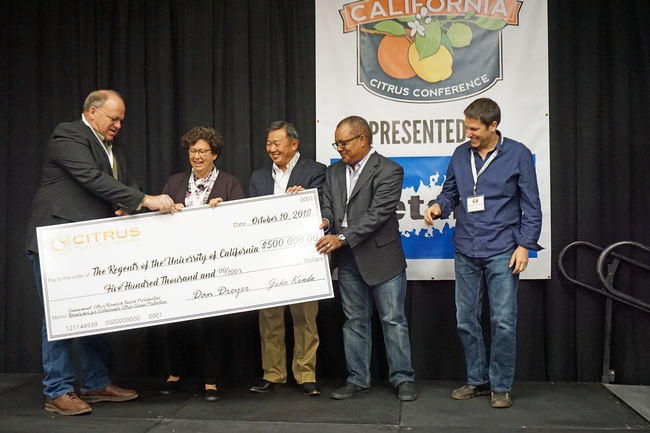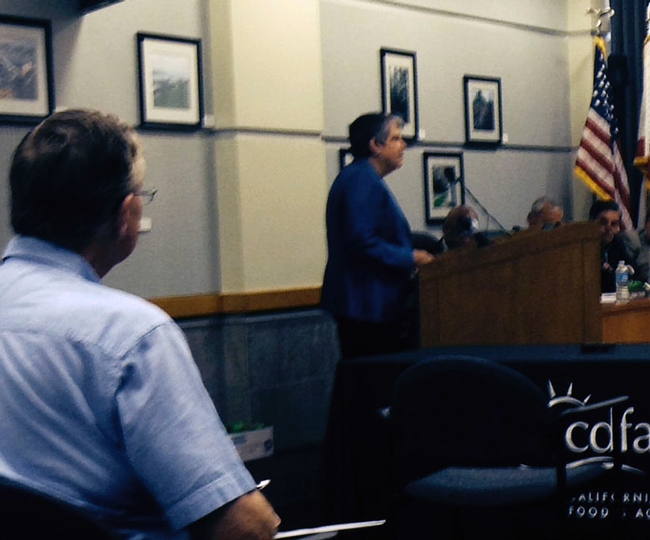Posts Tagged: board
The Citrus Research Board and UC create a $1 million endowment for citrus research
The Citrus Research Board and UC Agriculture and Natural Resources have established a $1 million endowment to fund the Presidential Researcher for Sustainable Citrus Clonal Protection at the UC Lindcove Research and Extension Center. The endowed researcher will provide a UC Cooperative Extension scientist a dedicated source of funds to support scholarly activities focused on the long-term sustainability of the citrus industry.
“I wish to thank the Citrus Research Board for establishing the Presidential Researcher for Sustainable Citrus Clonal Protection at LREC endowment,” said UC ANR vice president Glenda Humiston. “This gift, coupled with the $500,000 match from the UC Office of the President, will help to ensure the long-term success of exemplary research focused on the California citrus industry.”
UC President Janet Napolitano provided half the funds for the endowed researcher; the CRB donated the other half.
“We are gratified that President Napolitano has selected the CRB for this prestigious match program,” said CRB Chairman Dan Dreyer. “It will be invaluable in helping us to pursue critical research that will yield beneficial findings to support the sustainability of the California citrus industry.”
The new endowment supports the UC Citrus Clonal Protection Program, which distributes pathogen-tested, true-to-type citrus budwood to nurseries, farmers and the public to propagate citrus trees for commercial and personal use. The CCPP maintains blocks of trees that serve as the primary source of budwood for all important fruit and rootstock varieties for California's citrus industry and researchers.
The CCPP is a cooperative program between UC ANR, CRB, the California Citrus Nursery Board and the California Department of Food and Agriculture. CCPP director Georgios Vidalakis, UC Cooperative Extension specialist in plant pathology at UC Riverside, shared his appreciation for the efforts that led to the creation of the new endowed researcher position.
“My thanks to the citrus growers for their decades-long support, especially the members of the CCPP committee of the CRB for their vision, and UC's Greg Gibbs for coordinating all of the efforts,” he said. Vidalakis also praised Lindcove director Elizabeth Grafton-Cardwell “for making the case to our growers about the importance of this endowment and for making plans to house the UC ANR endowment at the LREC.”
A selection committee will award the endowment to a distinguished UC ANR academic. An annual payout will be used to provide salary, graduate student and/or program support. The researcher will be named for a five-year term. At the end of that period, the appointment will be reviewed and either renewed or taken back to a selection committee to choose another UC ANR academic.
“I would like to thank the CRB for this generous gift and their continued support of our research for CCPP at the LREC,” said UC ANR Director of Major Gifts Greg Gibbs.
The CRB administers the California Citrus Research Program, the grower-funded and grower-directed program established in 1968 under the California Marketing Act as the mechanism enabling the state's citrus producers to sponsor and support needed research. More information about the Citrus Research Board may be found at www.citrusresearch.org.
The Presidential Researcher for Sustainable Citrus Clonal Protection is the fifth $1 million UC ANR endowment to support California agriculture. The other endowments are:
- UC Cooperative Extension Presidential Chair for Tree Nut Genetics, formed with the California Pistachio Research Board in October 2015
- UC Cooperative Extension Presidential Chair for Tree Nut Soil Science and Plant Water Relations, formed with the California Pistachio Research Board in October 2015
- UC Cooperative Extension Presidential Chair for California Grown Rice, formed with the California Rice Research Board in September 2016
- UC Cooperative Extension Presidential Chair for Agricultural Education in Orange County, formed with the Orange County Farm Bureau in October 2017
Napolitano presents UC initiative to state food and agriculture board
The UC Global Food Initiative is intended to marshal the university's resources – including curriculum and world-class research, student efforts and operational efforts in place across the university's 10 campuses – to address global challenges related to food.
“This initiative grows out of a commitment made by all 10 UC campus chancellors and myself,” Napolitano said. “It is a commitment to work collectively to put a greater emphasis on what UC can do as a public research university, in one of the most robust agricultural regions in the world, to take on one of the world's most pressing issues.”
The food initiative will build on UC's tradition of innovative agricultural research to support farmers and ranchers. Future efforts will build on work already begun by UC's 10 campuses and its Division of Agriculture and Natural Resources (ANR) to address internal and external issues with a variety of approaches.
UC research, for example, taught Californians how to remove salts from the alkali soils in the Central Valley, transforming that barren landscape into one of the world's most productive farming regions, Napolitano noted in her presentation to the California State Board of Food and Agriculture.
Today, the World Food Center at UC Davis stands with 26 other centers dedicated to food and agriculture on that campus; students and faculty at UC Santa Cruz are transforming the field of agroecology; and the Berkeley Food Institute is studying the relationship between pest control, conservation and food safety on Central Coast farms. The cutting-edge Healthy Campus Initiative at UCLA taps all members of the campus community.
The initiative is not limited to seeking any single solution or set of solutions to the myriad food issues confronting the world, Napolitano said.
“The idea,” she said, “is to provide the intellectual and technical firepower, as well as the operational examples needed for communities in California and around the world to find pathways to a sustainable food future.”
In describing the building blocks for the initiative, Napolitano noted that the university's agricultural outreach and public service programs – in every California county and more than 100 nations – bring UC resources to individuals and communities to help them access safe, affordable and nutritious food while sustaining scarce natural resources.
The university's work also will help inform and drive policy discussions from the local to the international levels, and expand partnerships with government agencies such as the California Department of Food and Agriculture.
“This initiative shows great vision and leadership from President Napolitano and the University of California,” said CDFA Secretary Karen Ross, “Climate change and population growth will greatly strain our ability to provide healthy food to people here and around the world.
“President Napolitano's proposal to leverage the strategic assets of the entire UC organization makes it a valuable partner in addressing the significant challenges and opportunities for our production agriculture and food system.”
Emphasizing that student engagement is key, Napolitano announced, as one of her first actions, the funding of three $2,500 President's Global Food Initiative Student Fellowships to be awarded on each campus to undergraduate or graduate students. The fellowships will fund student research projects or internships.
Among other early efforts to be undertaken as part of the initiative are the following:
- Internally, campuses will heighten their collective purchasing power and dining practices to encourage sustainable farming practices, and model healthy eating and zero food waste; food pantries and farmers markets that exist on some campuses will be spread to all 10. Partnerships with K-12 school districts to enhance leveraging procurement for these purposes also will be explored.
- Food issues will be integrated into more undergraduate and graduate courses, catalogues of food-related courses will be developed, and demonstration gardens will be made available on each campus to increase opportunities for students to participate in experiential learning.
- Data mining of existing information will be deployed to help develop insights and action plans for California agriculture and responses to climate change.
- New policies will be enacted to allow small growers to serve as suppliers for UC campuses.
Related links
California State Board of Food and Agriculture
UC Division of Agriculture and Natural Resources
The fruits of their labors
Summer time...and the livin' is easy.
But not for the bees. Worker bees, which live about four to six weeks, literally work themselves to death gathering nectar, pollen, propolis (plant resin) and water to bring back to their colony.
So, when you sit down to summer meals, you can thank a bee.
Extension apiculturist Eric Mussen of the UC Davis Department of Entomology and Nematology, says one-third of the American diet is pollinated by bees. Without bees, we'd be eating such wind-pollinated grains as wheat and rice.
Our gardens and orchards yield such favorites as carrots, cucumbers, onions, apples, grapefruit, oranges, pears, cherries, raspberries, strawberries, blueberries, lima beans, sunflowers and almonds.
All pollinated by honey bees.
Cole crops, such as cabbage, Brussel sprouts, collards, kale, kohlrabi, spinach, chard and broccoli?
All pollinated by honey bees.
Even milk and ice cream are linked closely to the honey bee. Cows feed on alfalfa, which is pollinated by honey bees (along with other bees). Ice cream ingredients usually include fruits and nuts, other bee favorites.
The ever-popular fruit salad features blueberries, apples, oranges and pomegranates.
All pollinated by honey bees.
An apple a day may keep the doctor away, but without the bees, we'd have no apples.
Love apples and honey? Here are two recipes from the National Honey Board celebrating both honey and apples.
Apple honey crisp
2 lbs. apples, quartered and sliced (1-1/2 quarts)
1/2 cup plus 1/4 cup honey, (separated)
1 teaspoon cinnamon
1/2 teaspoon nutmeg
1 cup flour
1/4 cup butter, softened
Warm Nutmeg Cream, (recipe follows) or ice cream
Toss apples with 1/2 cup honey, cinnamon and nutmeg in bowl. Turn into 2-quart baking dish. For topping, beat flour with butter and 1/4 cup honey until crumbly; sprinkle over apples. Bake at 350 degrees for 40 to 45 minutes or until apples are tender and topping is golden. Serve with warm nutmeg cream or ice cream.
Warm nutmeg cream
1/2 cup whipping cream
2 tablespoons honey
2 tablespoons butter
1/4 teaspoon nutmeg
Combine all ingredients in saucepan and bring to boil. Simmer, stirring often, for 5 minutes or until mixture thickens slightly.
Honey apple cake
1/3 cup butter or margarine
1/3 cup packed brown sugar
2 eggs
1/3 cup honey
1 teaspoon grated lemon peel
1-1/2 cups flour
1 teaspoon baking powder
1/2 teaspoon baking soda
1/2 teaspoon ground cinnamon
1/4 teaspoon salt
1/4 teaspoon ground nutmeg
1/8 teaspoon ground allspice
1/4 cup water
1 cup (1 medium) pared, cored, & chopped apple
1/4 cup chopped walnuts
Honey Apple Topping
Cream butter and sugar until light and fluffy. Add eggs, one at a time; beat after each addition. Beat in honey and lemon peel. Combine flour, baking powder, soda, spices and salt; mix well. Add to creamed mixture alternately with water; begin and end with dry ingredients. Stir in apples and nuts. Turn into greased and floured 9-inch heart-shaped or round cake pan. Bake at 325 degrees F. for 45 to 55 minutes or until wooden toothpick inserted near center comes out clean. Cool 10 minutes and remove from pan. Cool completely. Brush top of cake with sauce from honey apple topping; arrange topping on cake.
Honey apple topping
1/3 cup honey
2 tablespoons rosé wine
2 tablespoons lemon juice
2 medium apples
Heat honey, rosé wine and lemon juice. Core and slice 2 medium apples; add to honey. Cook until tender and glazed; turn slices halfway through cooking. Makes topping for one 9-inch cake.
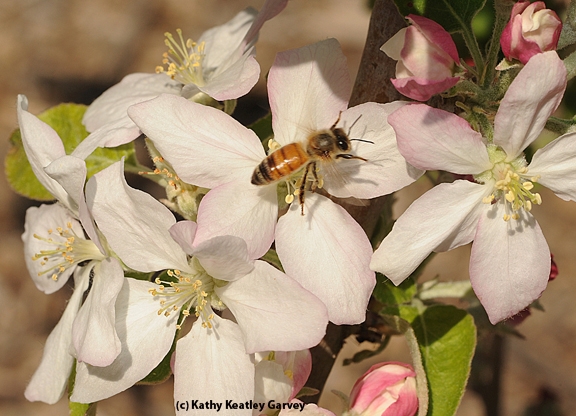
Honey bee pollinating apple blossom. (Photo by Kathy Keatley Garvey)
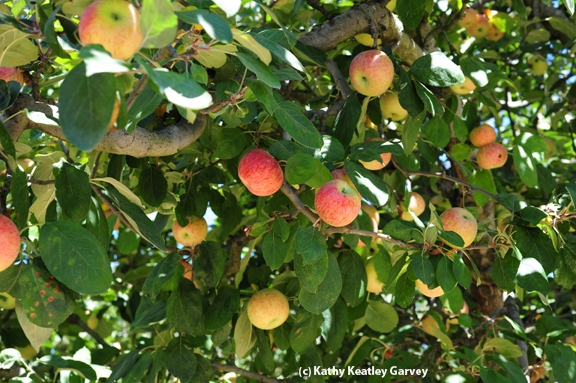
Gravenstein apples ready to be picked. (Photo by Kathy Keatley Garvey)
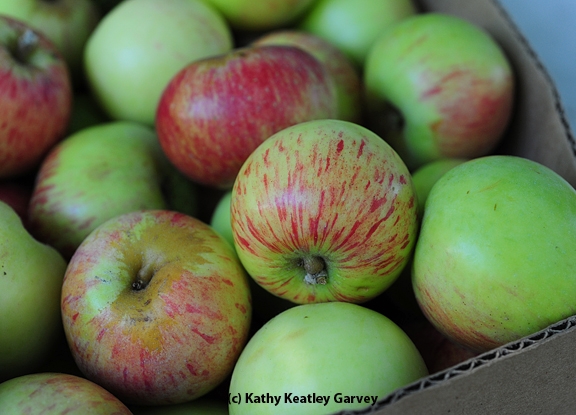
Gravenstein apples ready to eat. (Photo by Kathy Keatley Garvey)

